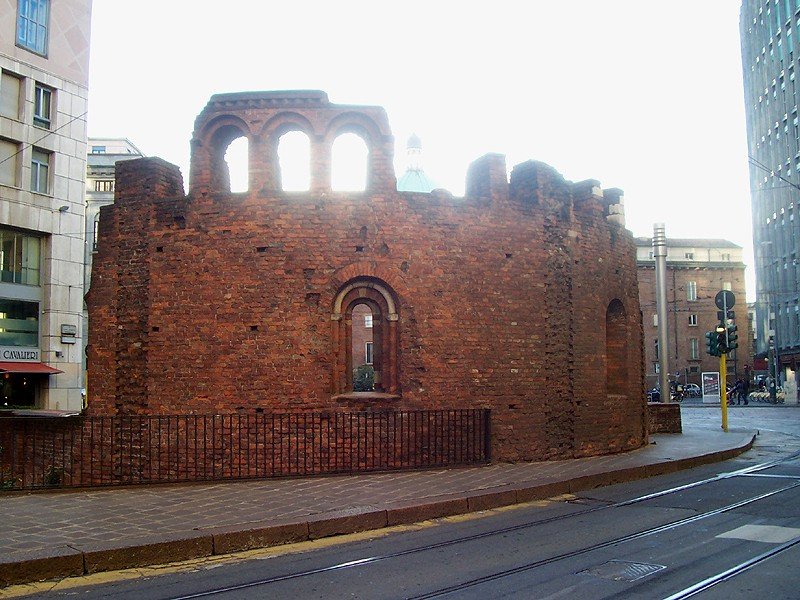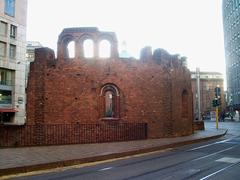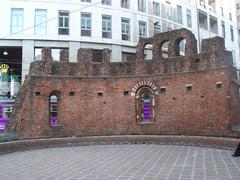
San Giovanni in Conca Milan: Visiting Hours, Tickets, and Historical Guide
Date: 14/06/2025
Introduction
San Giovanni in Conca, located in Piazza Missori, is one of Milan’s most fascinating yet overlooked historical sites. With origins in late antiquity, the site offers a unique glimpse into Milan’s evolution from Roman times through the medieval era and into the modern cityscape. While much of the original church has been lost—primarily due to destruction during Emperor Frederick Barbarossa’s sack of Milan and later urban redevelopment—the preserved Romanesque crypt and partial apse remain accessible, providing a rare window into the city’s ecclesiastical and dynastic heritage.
San Giovanni in Conca is especially significant for its association with the powerful Visconti family, who transformed it into their private chapel and mausoleum in the 14th century. Today, visitors can explore the crypt, admire medieval fresco remnants, and trace Milan’s layered architectural history, all within walking distance of the Duomo and other central attractions.
For those planning a visit, it’s crucial to check current opening hours, ticket requirements, and accessibility details, as the site has limited public access. This guide consolidates essential historical context, practical visitor information, and travel tips to help you make the most of your experience at San Giovanni in Conca.
Table of Contents
- History and Architectural Evolution
- Romanesque Crypt and Artistic Features
- Visiting Information
- Visitor Experience: What to Expect
- FAQ
- Conclusion
- References and Sources
History and Architectural Evolution
Early Christian Foundations
San Giovanni in Conca was originally constructed in the 5th or 6th century CE on the site of a former Roman domus within the city walls of ancient Mediolanum (Medieval Milanetc). The church’s name, “in Conca,” refers to the shallow depression or “bowl” in which it was built. Archaeological excavations have uncovered mosaic pavements from the original basilica—some of which are now preserved in the Museo Archeologico di Milano (Touring Club Italiano).
Medieval Transformations
The church was rebuilt in the 11th century in the Romanesque style, featuring a single nave and semi-circular apse. It was destroyed during Frederick Barbarossa’s sack of Milan in 1162, but was soon reconstructed on a grander scale, adding aisles, a transept, and a bell tower. The new façade featured a niche depicting St. John, referencing the church’s dedication.
The Visconti Era
In the 14th century, San Giovanni in Conca became the private chapel and mausoleum of the Visconti dynasty. Lavish funerary monuments were installed, including the tomb of Bernabò Visconti, which is now preserved at Castello Sforzesco. The church’s role as the Visconti family mausoleum added layers of artistic and historical significance (everybodyhatesatourist.net).
Modern Decline and Preservation
From the 19th century onward, San Giovanni in Conca faced deconsecration, partial demolition, and repurposing—first as a warehouse, later as a Waldensian church. Most of the structure was demolished after World War II during urban development. Only the crypt and a portion of the apse remain today, thanks to preservation efforts led by local heritage organizations and the Touring Club Italiano (Touring Club Italiano).
Romanesque Crypt and Artistic Features
The crypt of San Giovanni in Conca, rebuilt in the 11th century, is Milan’s only major surviving Romanesque crypt. It is divided into three naves by rows of columns—many of which reuse materials from earlier periods—and features characteristic Romanesque capitals with geometric and vegetal motifs (italia-italy.org). While most frescoes have been lost, fragments remain, hinting at the church’s once-rich decoration. The crypt originally housed the tombs of Visconti family members and is considered a hidden treasure for those interested in medieval art and archaeology.
Visiting Information
Opening Hours
- Visiting days and hours: The crypt is not open daily. Public access is generally limited to specific dates, often weekends and special events, as organized by the Touring Club Italiano’s volunteers or the city’s cultural programs. Hours typically range from late morning to late afternoon (Touring Club Italiano).
- Recommendation: Always check the official Touring Club Italiano page or local tourism sources before planning your visit.
Tickets and Access
- Admission: Entry is generally free, though donations to support preservation are welcome. On rare occasions, there may be a modest fee or advance booking requirement for guided tours.
- Guided tours: Volunteer guides are often present during open days and provide valuable historical context.
Accessibility
- Mobility: The crypt is a subterranean medieval structure accessed by stairs, making it difficult for visitors with limited mobility. There are no elevators or ramps.
- Advice: Contact the site in advance via the Touring Club Italiano or local tourist office for the latest accessibility information.
How to Get There
- Location: Piazza Missori, Milan.
- Public transport: The Missori Metro station (Line 3 – Yellow Line) is adjacent. The site is a short walk from the Duomo and other major historical landmarks.
Best Time to Visit
- Quieter moments: Early mornings or late afternoons, especially on weekdays or during special openings, offer the most peaceful atmosphere.
- Seasonal considerations: Confirm dates and hours, as they may vary seasonally.
Nearby Attractions
- Duomo di Milano: Iconic Gothic cathedral, 5 minutes’ walk away.
- Sforza Castle: Museum complex and home to the Visconti tombs.
- Galleria Vittorio Emanuele II: Historic shopping arcade.
- Museo Archeologico di Milano: Houses original mosaics from San Giovanni in Conca.
Tours and Events
- Guided tours led by knowledgeable volunteers are available during open days.
- Occasionally, special events or virtual tours are offered—details are announced on the official Touring Club Italiano website.
Visitor Experience: What to Expect
Upon entering through a discreet street-level entrance, visitors descend into the cool, atmospheric crypt—a space defined by ancient columns and the play of natural light. Interpretive panels and on-site volunteers offer context, sharing the crypt’s significance as both a spiritual and dynastic landmark. The intimate scale and evocative setting stand in contrast to Milan’s larger, busier attractions, making San Giovanni in Conca ideal for travelers seeking authentic, off-the-beaten-path experiences (My Path in the World).
Photography is permitted (no flash), allowing visitors to capture the crypt’s unique architectural details.
Frequently Asked Questions (FAQ)
Q: What are the current visiting hours?
A: The crypt is open only on select dates, often weekends or during special events. Always check the official schedule before your visit.
Q: Is there an entrance fee?
A: Admission is typically free, but donations are appreciated. Occasionally, special tours may require a modest fee.
Q: Is the site accessible for wheelchair users?
A: Accessibility is limited due to stairs and uneven surfaces.
Q: Are guided tours available?
A: Yes, volunteer-led tours are offered during open days and greatly enrich the visit.
Q: Can I take photos inside?
A: Yes, photography is allowed without flash.
Q: What other attractions are nearby?
A: The Duomo di Milano, Sforza Castle, Galleria Vittorio Emanuele II, and Museo Archeologico di Milano are all within walking distance.
Conclusion
San Giovanni in Conca stands as a rare and poignant testament to Milan’s ancient and medieval history. Its Romanesque crypt, Visconti connections, and vivid past offer visitors a unique and intimate journey into the city’s heritage. With limited but rewarding public access, it is a hidden gem for those seeking to explore Milan beyond the usual tourist circuit. For the latest information on visiting hours, tickets, and guided tours, always refer to official resources.
To deepen your Milan experience, consider combining your visit to San Giovanni in Conca with nearby historical sites and museums. For ongoing updates and more guides, download the Audiala app and follow us on social media.
References and Further Information
- Touring Club Italiano: La Cripta di San Giovanni in Conca a Milano
- Italia Italy: Cripta San Giovanni in Conca
- Medieval Milanetc: Milan’s Big Yellow Taxi – The Ruins of San Giovanni in Conca
- EverybodyHatesATourist.net: Best Things to Do in Milan
- Academia.edu: Diachronic Representation of Ancient Buildings
- My Path in the World: Non-Touristy Things to Do in Milan
- Archaeological Museum of Milan – Official Website
- YesMilano – Official Milan Tourism Website





























































